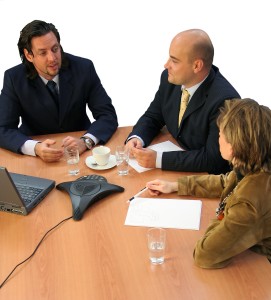Introduction
As the distinction between information and communication technology blurs and the pressure to cut costs increases, tele-conferencing has become more and more popular. Colleagues are able to participate without making any special preparations or adding any new pieces of technology to their desktop.
However, this requires some procedural consideration to ensure that this form of communication has credibility, trust and effectiveness. Below are some suggested “guidelines for engagement” that could be employed above and beyond the requirements of a normal meeting.
Preparing
- When checking with participants, specify the tele-conference time in each time zone; don’t forget to take into account Daylight Savings!
- Advise participants of the tele-conference process; give them an un-involved colleague’s contact details in case of problems
- Visit any proposed location and familiarise yourself with it; assess risks (eg, listen for any noise that might reduce audio quality)
- Arrive 15 minutes early to make sure the facility is fully functional, and that you are familiar with the procedures
- Minimise interruptions by closing the door and hanging a “do not disturb” sign
Chairing
 Be conscious of the microphone; avoid placing papers or other objects on top of microphones; and consider removing, hard watches bracelets or bangles that may rattle against the desk
Be conscious of the microphone; avoid placing papers or other objects on top of microphones; and consider removing, hard watches bracelets or bangles that may rattle against the desk- Start on time; acknowledge and be sensitive to the “on-timers”; late-comers will soon realise that starting on time means just that
- As you begin, ask other sites if they can hear you; take a roll-call and ask each participant by name if there are any issues with reception and/or participation
- Ensure all people involved in the conference are aware of each other’s presence; make sure you introduce anyone who joins the tele-conference after introductions
- When participants aren’t familiar with each other, have them briefly introduce themselves; this also helps with assessing if vocal style or technology might be an issue (speed, volume, etc)
- If reasonable, after each agenda item check with each participant by name for questions or comments
- Because of the audio delay sometimes experienced, use a brief pause between speakers to ensure the full audio has been transmitted
- Ensure all participants have the opportunity to fully participate; engage quiet ones by asking them a question or asking them for their opinion
- When closing, outline what was discussed and agreed, itemise any actions to be taken by who and by when, and if reasonable check with each participant by name for questions or comments
- Clearly end the tele-conference by signing off and instructing participants to hang up.
Manners
- Turn off your mobile phone or make the ring tone discrete; their signals may disrupt the tele-conference
- Identify yourself when you start speaking; periodically pause so that others may provide input
- If you have a strong accent or normally speak quickly or quietly, check your speed & volume with your fellow participants
- Avoid interrupting other speakers; jot down points as you think of them for later reference
- Minimise side conversations and avoid whispering or talking to people co-located with you
- Avoid drumming fingers, rustling papers, clicking pens or tapping the table
- Avoid putting your phone on hold; this may leave participants with annoying lift muzak
- When you are not speaking, use the mute button; but remember to un-mute yourself when you wish to contribute
- Address participants by name; as there are no visual cues, it’s very difficult for other participants to determine who is being addressed
- Address questions to specific participants; this ensures your question is answered rather than greeted with silence as participants try to figure out who should respond
- If you withdraw from or rejoin the tele-conference, advise participants accordingly
Helpful hints
- When participants aren’t familiar with each other, consider including a short biography on each in the agenda papers
- Avoid mobile phones and cordless phones; they can transmit static
- Avoid speaker-phones; some don’t allow you to speak and listen at the same time
- Consider a periodic refreshment break every hour or so; it’s hard work listening for an extended period of time
- If necessary, consider recording your tele-conference so that you can prepare accurate minutes; but seek participants’ permission first; they may wish to withdraw!
- Encourage feedback on the tele-conference process; you may wish to ask participants how they think it went, and how it can be improved
- Consider dealing with more critical issues in a less problematic way; if you must tele-conference, prepare clear & concise agenda papers
- Consider other technological options including video-conferencing, blogging, chat-rooms, and the like.
When you’re ready to talk, we’re ready to listen – so contact the Hub!